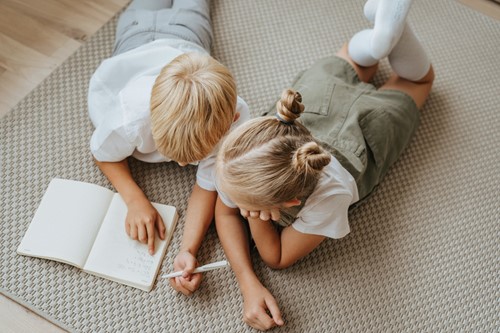From Making a Mess to Making a Mark: How Children Develop Writing Skills
Ann Stubbs, our Early Childhood Area Director, shares some ideas about how you can help your children become competent and confident mark-makers and writers.
Children begin their journey towards writing by making marks, not forming letters and words. Babies love to make marks in spilled food, splatting spilled liquid, touching it with their fingers and palms of their hands, creating patterns.

View this as an opportunity to make marks, not making a mess. Babies need the sensory experiences of seeing the marks their fingers make - these marks have meaning! This is the first sign that they are becoming interested in mark-making, and the marks they make will begin to have more meaning for them as they progress.
Developing Motor Skills
All children are different and develop at their own unique pace, progressing gradually through a range of stages before they are physically able to hold a pencil, paintbrush or pen to write letters and numbers and draw recognisable figures. Here are some fun activities to help this development:
- Start big! Babies and younger children need opportunities to make big movements on large sheets of paper, rolls of old wallpaper or ground sheets, exploring paint and sensory materials such as “gloop” (made from cornflour and water). These activities are fantastic for developing shoulders and elbows, which in turn will help the development of the finer motor skills needed in wrists and fingers to hold and manipulate mark-making tools.
- It isn’t just all about art – housework can be a fun activity too! Give your child the opportunity to help to sweep up with the dustpan and brush or a child-sized broom. This activity is ideal for developing their shoulder and elbow muscles, strengthening the arms and developing inner body coordination.
- Moving on to the finer motor development and hand to eye coordination, children enjoy using tools such as salad tongs to pick up small objects and transport them from one container to another - like pompoms in bun trays or moving buttons or dried pasta from one container to another.
Learning to Hold Mark-Making Tools
Children will go through a range of stages in holding writing tools. They will use a grip that is within their stage of development and which feels most comfortable to them. They will almost certainly still be deciding which hand they prefer to use, but young children will often swap hands and use both.
- Younger children and babies will hold mark-making tools using a whole hand grip called a ‘Palmar grasp.’ This grip is a strong grip that helps them to hold the tools firmly and make marks. The smaller the hand, the bigger the tool needs to be to enable small chubby hands to be able to grasp comfortably.
- In the next stage of development children will often use a ‘Tripod grip’ - using three fingers, usually holding at the top of a pencil, crayon or chalk. By this stage, they will usually be using their ‘dominant hand’ - the one which feels most comfortable to use: however, it is important not to discourage the use of both. Give your child opportunities to use a ‘still hand’ and a ‘moving hand’ - for example, screwing bottle tops on or using a padlock and key. These activities will continue to support their fine motor skills.
- The “Pincer grasp” involves the coordination of the index finger and thumb to hold the writing tool. This grip requires multiple skills including finger strength and precise control in the hands – and is where all that ground work from the BIG movements, developing shoulders, elbows and wrists will have paid off.
- Children will now have more control over their hands and fingers, so will be able to make marks on smaller canvasses and become increasingly skilful in controlling their writing tools. They will be beginning to form recognisable marks and possibly some letters or numerals. Perhaps they may be able to write their name.
The role of parents and carers in helping children to become competent and confident mark makers and writers is vital. You can support your child at home by exploring some of the above ideas to help develop their skills at each stage of development and at their own unique pace. Please ask your child’s key worker if you would like some additional ideas for home learning around writing and drawing.
Happy mark-making!
For further reading around writing and drawing, please check out the websites here and here.
This article was kindly provided by Bright Horizons Family Solutions, the UK’s leading childcare provider. With a portfolio of over 300 nurseries and a 30 year history, they have been trusted by many families to provide children with naturally inspiring, exceptional care and education for the early years.